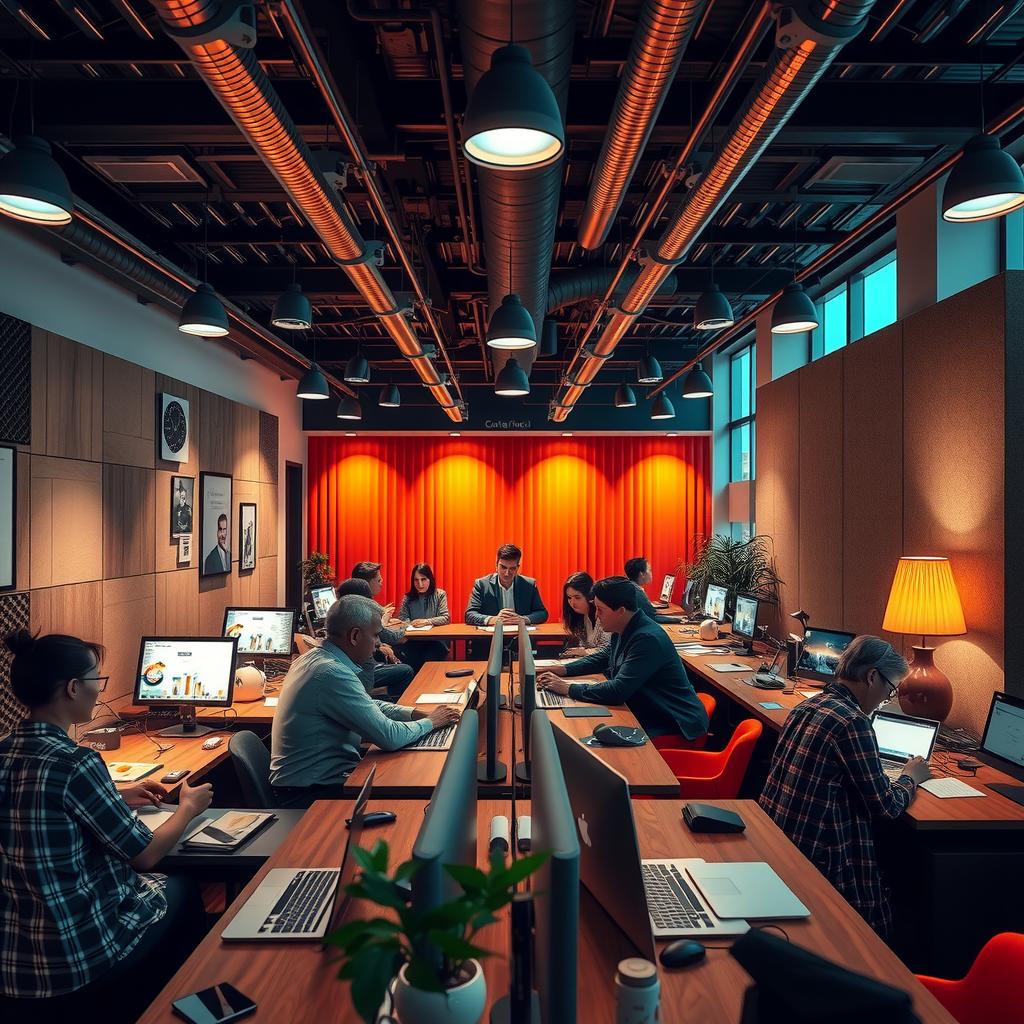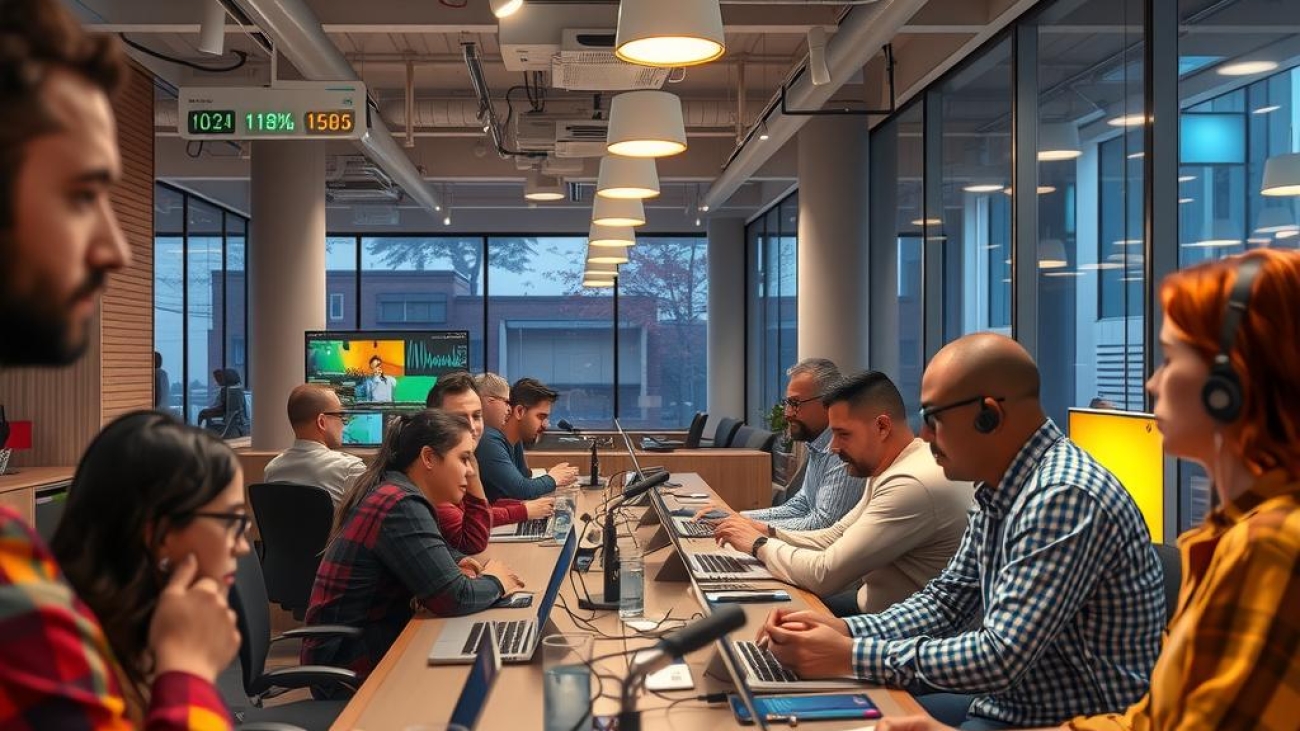In today’s fast-paced work environment, have you ever found yourself struggling to concentrate amidst the cacophony of ringing phones, chattering coworkers, and the relentless hum of office machinery? This phenomenon is increasingly familiar in shared workspaces where collaboration often comes at the cost of personal focus. The reality is that background noise can significantly impact workplace productivity, making it essential for organizations to adopt effective sound management strategies. Fortunately, various acoustic solutions are available that not only enhance individual concentration but also foster a more collaborative atmosphere.
The core value of this blog post lies in its exploration of innovative background noise reduction tools specifically designed for shared workspaces. By addressing common challenges associated with an active office environment, these tools provide practical methods to mitigate distractions and improve overall efficiency. As companies strive to create a harmonious balance between teamwork and individual productivity, understanding how these tools function becomes crucial.
From advanced noise reduction headphones like the Bose Noise Cancelling Headphones 700 to sophisticated room treatment options such as acoustic panels from Auralex, there exists a plethora of products tailored for diverse workspace needs. These resources not only help employees minimize disruptive sounds but also contribute positively to their mental well-being by creating a quieter sanctuary within bustling surroundings.
As professionals navigate through collaborative projects while seeking their own space for focused tasks, integrating effective collaboration tools becomes paramount. By utilizing technologies designed with sound management in mind—like Krisp, which filters out background noise during virtual meetings—teams can communicate more effectively without losing sight of their individual objectives.
This article will delve deeper into specific background noise reduction solutions, examining how they transform traditional office environments into more conducive settings for both teamwork and personal focus. So whether you’re working in an open-plan layout or sharing an office with multiple colleagues, read on to discover practical insights that could revolutionize your daily workflow!

Key Insights:
-
The Importance of Acoustic Solutions: In shared workspaces, the presence of background noise can severely impact workplace productivity. By implementing advanced acoustic solutions, organizations can create an environment that significantly reduces distractions, allowing employees to focus more effectively on their tasks.
-
Innovative Collaboration Tools: To address the challenges posed by background sound, it is crucial for businesses to invest in innovative collaboration tools. These tools are designed specifically for sound management and integrate seamlessly into existing office environments. They play a vital role in maintaining team dynamics while fostering creativity during brainstorming sessions.
-
Technology-Driven Noise Reduction Methods: Embracing technology-driven methods for noise reduction not only enhances employee satisfaction but also contributes positively to retention rates. By creating a more conducive working atmosphere within shared workspaces, companies can maintain an inviting yet functional environment that respects both individual needs and collaborative efforts.

The Challenge of Background Noise
Understanding Its Impact on Productivity in Shared Workspaces
Background noise has emerged as a significant factor influencing workplace productivity, particularly in shared workspaces. In these environments, the cacophony of conversations, ringing phones, and general commotion can create an atmosphere that stifles focus and creativity. Research indicates that excessive background noise not only hinders concentration but also increases stress levels among employees. This phenomenon underscores the necessity for effective sound management strategies to foster a more conducive office environment. Employees thrive best when they are able to enter a flow state—a mental condition where they can engage deeply with their tasks without distractions. Unfortunately, the constant interruptions caused by surrounding sounds can disrupt this state and lead to decreased performance.
Moreover, background noise affects collaboration efforts within open-plan offices or shared spaces designed for teamwork. While these environments aim to promote interaction among team members through proximity and accessibility, they often fail due to auditory distractions that detract from meaningful communication. When individuals struggle to hear each other over ambient noise levels, misunderstandings may occur—ultimately undermining the effectiveness of collaborative initiatives. Organizations must recognize that addressing noise reduction is vital not only for individual productivity but also for fostering successful teamwork dynamics.
To combat these challenges effectively, companies should consider implementing various acoustic solutions tailored to their specific workspace needs. This could involve integrating sound-absorbing materials into office design or utilizing innovative products such as acoustic panels or white noise machines that help mask disruptive noises while enhancing overall sound quality within the space. Such adjustments contribute significantly toward creating an inviting atmosphere where employees feel comfortable expressing themselves creatively without fear of interruption.
Furthermore, adopting modern technology like advanced collaboration tools designed specifically for noisy environments may further alleviate issues stemming from background disturbances in shared workspaces. These tools enable seamless communication even amidst chaos by providing platforms where discussions can continue uninterrupted through virtual channels when necessary.
In conclusion, recognizing and mitigating the effects of background noise is crucial for enhancing employee performance across various dimensions—from individual focus and creativity to collective collaboration efforts within teams—and ultimately leads organizations toward greater workplace productivity outcomes in today’s dynamic business landscape.
Innovative Acoustic Solutions
Elevating Workplace Productivity through Sound Management
In modern office environments, particularly in shared workspaces, managing background noise has become increasingly paramount for enhancing workplace productivity. Various acoustic solutions have emerged to address this challenge, providing effective means to reduce sound disturbances that can disrupt focus and collaboration. Employing advanced materials such as sound-absorbing panels and innovative ceiling designs can significantly mitigate the harshness of echoing sounds that often plague open-plan offices. For instance, integrating acoustic wall treatments not only beautifies the workspace but also creates a more tranquil atmosphere conducive to deep concentration. Furthermore, technologies like sound masking systems generate ambient background noise that helps to obscure distracting conversations without being intrusive itself. Such tools are vital in fostering an environment where employees can seamlessly engage with their tasks while minimizing auditory distractions.
Collaboration Tools for Enhanced Communication
Facilitating Effective Teamwork Amidst Noise Disturbances
In addition to solid acoustic solutions, adopting cutting-edge collaboration tools is essential for navigating the complexities of a noisy working environment. Virtual platforms equipped with features like voice modulation and intelligent filtering play a crucial role in ensuring clear communication among team members scattered across different locations or within large office settings. By leveraging these collaboration tools, teams are better positioned to conduct meetings and brainstorm sessions without succumbing to interruptions from surrounding noises typical of dynamic workplaces. Moreover, integrating applications designed specifically for task management allows employees to prioritize objectives efficiently even amidst distractions—thereby maintaining momentum on projects despite external challenges posed by background noise. The synergy between robust acoustic strategies and state-of-the-art digital collaboration aids organizations in not only preserving workplace harmony but also amplifying overall productivity levels by creating an environment where ideas flow freely without auditory hindrance.
The Future of Workspaces: Fostering Collaboration through Acoustic Innovation
Enhancing Employee Experience with Advanced Noise Reduction Technologies
As the landscape of workspaces continues to evolve, organizations are increasingly recognizing the importance of creating environments that not only boost productivity but also foster a strong sense of community. A key aspect in achieving this balance lies in the strategic implementation of acoustic solutions designed to minimize background noise while encouraging collaboration among team members. In shared workspaces, where multiple activities often occur simultaneously, managing sound becomes vital for maintaining focus and enhancing workplace satisfaction. By leveraging advanced technology-driven approaches such as sound-absorbing materials and noise reduction systems, businesses can significantly improve their office environment and promote an inviting atmosphere conducive to teamwork.
The integration of specialized acoustic panels and intelligent sound management tools allows companies to tailor their workspace acoustics according to specific needs. For instance, open-plan offices often suffer from excessive background noise that hampers communication effectiveness; however, deploying strategically placed acoustic solutions can mitigate these disruptions by absorbing ambient sounds and reducing reverberation. This thoughtful application not only preserves privacy during discussions but also enables employees to engage more meaningfully without the constant distraction of surrounding chatter—a crucial factor in enhancing overall employee experience.
Moreover, investing in quality collaboration tools plays a pivotal role in complementing these acoustic enhancements. With virtual meetings becoming commonplace alongside physical interactions within shared spaces, integrating high-fidelity audio technologies is essential for ensuring seamless communication across various platforms. Such tools allow teams to collaborate effectively regardless of their location while minimizing technical challenges related to sound clarity or interruptions caused by environmental factors—thus reinforcing a culture centered on cooperation.
To illustrate this synergy between functionality and community spirit further, consider how innovative design elements like biophilic features can be incorporated alongside sound management strategies. Plants have been shown not only to improve air quality but also serve as natural sound barriers that enhance tranquility within busy workplaces. When combined with modern acoustic treatment methods—such as ceiling tiles engineered specifically for optimal absorption—the result is an invigorating workspace that promotes well-being while facilitating productive exchanges among colleagues.
By prioritizing both technological advancements focused on noise reduction along with initiatives aimed at cultivating a collaborative spirit among employees, organizations position themselves favorably for future success in dynamic marketplace conditions. As they continue exploring new avenues towards optimizing shared workspaces—balancing serenity with engagement—they lay groundwork fostering resilience against distractions ultimately leading toward improved workplace productivity across diverse industries.
Creating Inviting Spaces Through Thoughtful Design
Merging Functionality with Community Engagement
In today’s fast-paced world where remote working options abound, companies must think critically about how they design their physical spaces if they wish to attract talent back into traditional offices—or indeed create hybrid environments worth commuting for at all! A major consideration involves crafting areas marked by pleasant aesthetics paired harmoniously with effective sound management techniques.
Carefully selected furnishings contribute greatly here; ergonomic seating arrangements encourage comfort whilst promoting social interaction amongst coworkers who might otherwise remain isolated behind screens throughout long hours spent together indoors! Additionally incorporating “soft” finishes such as plush carpets or wall coverings aids significantly when mitigating unwanted echoes produced within large rooms filled activity participants engaged lively conversations!
Furthermore it’s imperative acknowledge inherent differences personal preferences exist regarding acceptable levels external stimulation experienced daily basis—from gentle murmurs laughter occurring nearby coffee station lunchtime gatherings buzzing excitement surrounding brainstorming sessions held conference rooms reserved exclusively those needing uninterrupted space concentrate deeply projects requiring utmost attention detail each individual brings table collaboratively pursuing collective aspirations aligning company goals mission statements alike!
Thus designers architects tasked reimagining contemporary workplaces face challenge striking equilibrium appealing ambiance characterized warmth inclusivity ensures everyone feels welcomed empowered thrive contributing fullest potential given opportunities arise further deepening connections forming friendships built mutual respect drive excellence performance benchmarks consistently met exceeded advancing corporate objectives sustainability relevance competitive market ever-changing demands posed professionals entering workforce today!
Ultimately embracing principles underpinning successful implementation thoughtful considerations around addressing issues related background noise coupled creative interventions elevates everyday experiences enjoyed workers enhances perceptions value derived associations forged organizational culture fundamentally impacts retention rates job satisfaction levels felt individuals participating journeys embarked upon collectively navigating complexities professional lives intertwined interconnectedness creates genuine bonds lasting impact beyond mere transactions completing tasks efficiently timely manner alone…
Leveraging Technology for Enhanced Workplace Dynamics
The Interplay Between Sound Management Tools and Team Collaboration
Advancements in technology have revolutionized how we approach workplace dynamics today—and none more so than through innovations geared towards improving workplace productivity via sophisticated noise reduction measures! Modern enterprises understand significance harnessing cutting-edge equipment available market streamlining processes incorporating integrated systems designed optimize efficiency maximize results achieved succinctly quickly without sacrificing quality care taken every step way ensuring each project undertaken progresses smoothly seamlessly transitioning phases completion milestones reached ahead schedule anticipated timelines set forth initially planned outset endeavors initiated early days inception concept creation propelled forward successfully achieved fruition collaborative efforts invested time energy resources pooled together resulting innovations birthed excellence delivered stakeholders served diligently attentively catered needs addressed accordingly feedback solicited continual improvement embraced wholeheartedly journey pursued relentlessly uncompromising
Frequently Asked Questions:
Q: What are some effective strategies for reducing background noise in shared workspaces?
A: One of the most effective strategies involves implementing tailored acoustic solutions that can significantly dampen disruptive sounds. These may include sound-absorbing panels, acoustic partitions, and specially designed furniture that minimizes noise transmission. Additionally, utilizing innovative collaboration tools allows teams to manage sound levels more effectively during meetings and brainstorming sessions.
Q: How do background noise levels impact workplace productivity?
A: Background noise can be a major distraction in an office environment, leading to decreased focus and efficiency among employees. Research has shown that high levels of auditory disturbances negatively affect individual performance as well as overall team dynamics. By addressing this issue through effective noise reduction methods, organizations can create a more conducive atmosphere for creativity and collaboration.
Q: Are there any technological solutions available for managing sound in open-plan offices?
A: Yes, there are numerous technology-driven options available today aimed at enhancing sound management in open-plan layouts. These solutions often include smart devices that monitor decibel levels or integrate with existing systems to provide real-time feedback on the acoustic environment. Such advancements not only help mitigate background noise but also contribute positively to employee morale by creating a comfortable workspace where individuals feel respected and valued.
